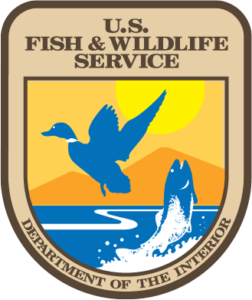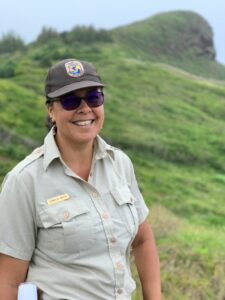Kauaʻi National Wildlife Refuge Complex
Mentor: Jennifer Waipa
Website: https://www.fws.gov/refuge/kilauea-point
STEM Fields: Conservation Ecology; Landscape Ecology; Wildlife Biology
Internship Research Goal: People need diversity of nature to thrive and live healthy lives. We work closely with local communities and our partners to help to facilitate providing and maintaining meaningful connections to special places and native species and habitats of Kauaʻi and to protect cultural resources, species and habitats for the benefit of current and future generations.
 About the Organization:
About the Organization:
The Kaua‘i National Wildlife Refuge Complex is part of a larger organization, the National Wildlife Refuge System, managed under the U.S. Fish and Wildlife Service to conserve, protect, and enhance fish, wildlife, plants, and their habitats for the continuing benefit of future generations.
The Kaua‘i NWR Complex is made up of 3 refuges: Kīlauea Point NWR, which was established in 1985 and is home to a variety of native and migratory seabirds, as well as the Daniel K. Inouye Kīlauea Point Lighthouse. This Refuge is one of the most visited refuges in the Refuge System and is open to the public via reservation several days a week and also includes a management focus of overall protection of native coastal strand and biodiversity.
Hanalei NWR and Hulē‘ia NWR, which were established in 1972 and 1973, respectively, under the Endangered Species Act to recover threatened and endangered species including 4 wetland bird species and the nēnē (Hawaiian goose).
Within the Kauaʻi Refuge Complex, we have several different programs that help fulfill our mission and purposes:
- The refuge biology program applies a variety of scientific methods to manage, inventory, and monitor wildlife and habitats. They also help facilitate research projects in coordination with a variety of other scientific agencies and organizations, as well as colleges and universities.
- The refuge visitor services program helps facilitate and improve the publicʻs understanding and connection with our refuges and the species and habitats we conserve at these refugees through interpretation and environmental education programs. We also facilitate wildlife-dependent recreation opportunities on refugees such as fishing.
- The refuge maintenance program helps with managing and restoring habitats that our wildlife need to thrive and they also play an important role in maintaining and building facilities and other infrastructure that helps support in management, education and administration.
- Our refuge law enforcement program provides support in managing public uses of our refuges and ensuring they are being conducted in a safe and meaningful way. They also help in outreach and education to our partners and the public about our refuges and conservation mission.
- Our refuge management, budget, and administration program helps to manage our refuges inline with our laws and policies, as well as to work with the partners and public to put forth effective management plans for our wildlife refuges that ensure that we are meeting our conservation goals and objectives. This program helps to oversee contracts, large construction projects, partnerships, interactions with and messaging to the public, as well as to help be the liaison for our refuges at the local, State, and Federal level and ensure fiscal responsibility and oversight of our public trust responsibilities.
 Meet Our Internship Mentor: Jennifer Waipa
Meet Our Internship Mentor: Jennifer Waipa
Jennifer Waipa is the Visitor Services manager at the Kauaʻi National Wildlife Refuge Complex and hails from the island of Hawaiʻi where she grew up, and served as an archeologist with Hawaiʻi Volcanoes National Park after having graduated from the University of Hawaiʻi at Hilo with a Bachelor’s degree in Anthropology as well as Speech and Communications. While serving as Visitor Services manager, her presence in the USFWS serves to facilitate native Hawaiian engagement and practices within management and programs.
INTERNSHIP DUTIES AND RESPONSIBILITIES:
Students will learn about the importance of native and endangered species in maintaining cultural health and vitality. They will also gain a better understanding of the approaches and challenges with managing wildlife and habitats within refuge lands on Kaua‘i.
- Learn about and how to identify the native, endangered seabird and wetland bird species we manage.
- Learn about and identify the native and beneficial plants/habitats that occur on our refuges.
- Gain a basic understanding as to how the refuge manages and restores habitats.
- Understand the role and importance of taro farming within Hanalei NWR and greater Hanalei watershed.
- Begin to build an understanding of how western science and traditional Hawaiian cultural practices can work together to achieve ecological sustainability.
- Get initial exposure to the structure and training required for wildlife management.
- Learn about our work with local communities and partners, as well as with the public to provide environmental education, interpretation and other meaningful experiences and projects on our wildlife refuges and beyond.
- Learn about conservation careers and other opportunities available.
INTERNS SHOULD BE COMFORTABLE WITH AND ABLE TO:
- Work in a hot, humid environment.
- Work with a variety of individuals and personality types.
- Review documents, research, and clear writing and communication.
- Discuss relevance of management techniques.
- Conduct hands-on work with native plant and bird restoration.
2023 Internship Schedule:
- Spring 2023: March 15th and 17th
- Summer 2023: June 13th – July 29th
*Schedules are tentative and are subject to change. Interns will be required to work 40 hours in the Summer 2023.
Internship Meeting Location:
Kilauea Point National Wildlife Refuge
3500 Kilauea Road
Kilauea, HI 96754
